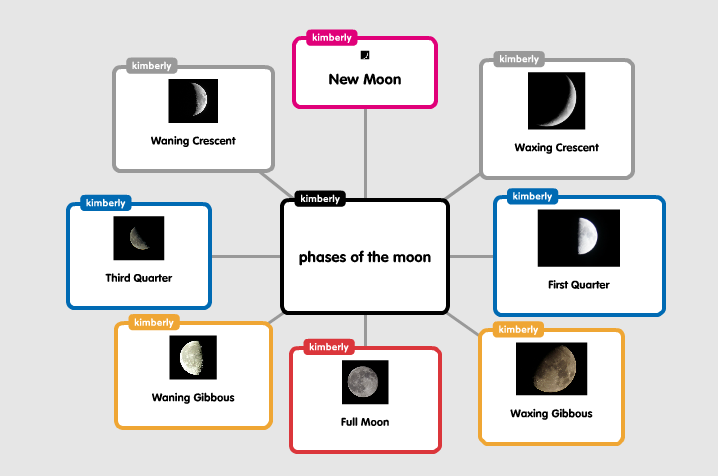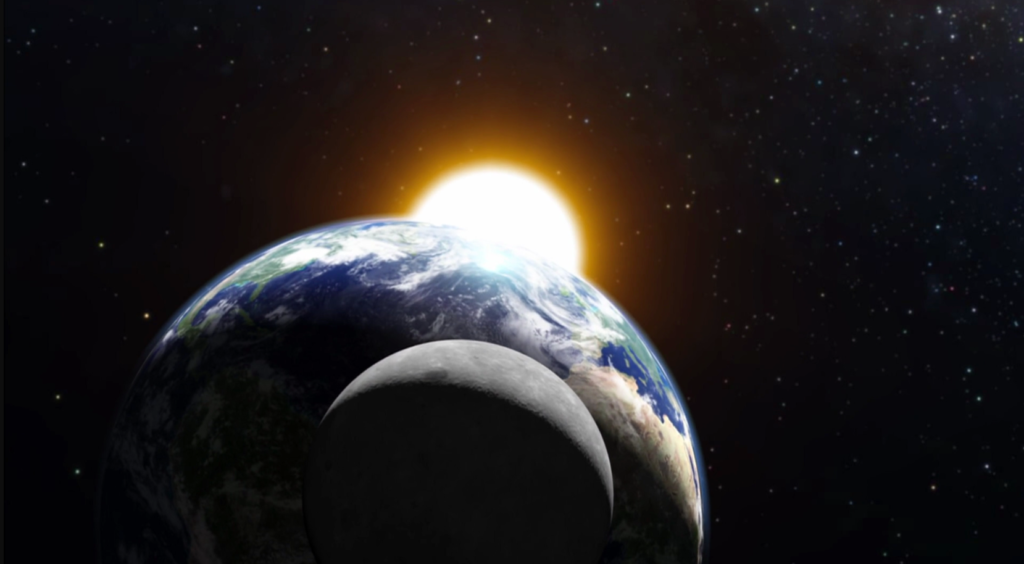Is there life on Mars? Do aliens exist? Where did we come from? How big is the Universe?… an infinite number of questions. The questions which scientists, philosophers, theologians, writers and possibly every sentient earthbound creature that ever looked upwards has been seeking answers to since the beginning of time. Popplet doesn’t have any answers, but it can help knowledge hungry learners to solve some of these Universal mysteries.
With futuristic hi-tech features, Popplet boldly goes where no app has gone before, allowing its users to create star maps, document planetary facts, and study stellar phenomena. All the while encouraging them to think big – Universe big!
There’s a lot of light years to cover, so let’s get started by setting our sights close to home on our planet’s nearest celestial neighbor: The Moon. We know it well, we’ve even visited, although admittedly not for a while; moon travel doesn’t come cheap!
What We Know: Fact Popplets
The Moon’s impact on the Earth, our visits, and the fact that it looms large as life most nights in the night sky means we already know quite a lot about it. The following fact popplet elegantly summarizes the most pertinent details. It was created by Nikki and published in her amazing class project blog. Nikki’s articles are as much about gaining an understanding of Popplet and other technologies as they are about the subjects under investigation. Nikki’s blog is definitely worth exploring further:
Like so many other things in our Universe, Nikki’s identity is a mystery to us. If Nikki encounters this article anywhere on the space-time continuum, we thank her and ask that she say hello.
Phases of The Moon
Our closest celestial body is a bit like ourselves: it goes through phases and sometimes appears as if it’s not there at all! – as in when it entirely blocks the Sun during an eclipse. This behavior used to be a bit scary before scientists were able to explain it all. Thankfully, the moon is now not such an unknown. We know that like ourselves, the moon’s phases are temporary, and it really is there all the time. Kimberley created this Popplet as an example for her students:

Oreos and the Lunar Phases
What do Oreos have to do with Life, the Universe, and Everything? Well, a significant number of children have learned and have remembered phases of the moon, by employing the much-loved cookie in their moon work. It’s trademark black and white color, its composition, and its overall popularity with younger learners make it a winner in the astronomy class. If you are thinking that presenting the lunar phases using Popplet might deny your students this educational milestone then fear not. Hungry students can still learn, and eat and savor their biscuits at the same time: All they need to do is take pictures of their research and add it to a Popplet like in the tasty example below:
The Moon: An Interactive Popplet Presentation
Popplet users never fail to amaze and inspire us. And the younger the creators, the more amazing and inspiring they are. The following set of Popplets is one of those amazing ideas we often see shared on a student’s classroom study blog. The following marvel is from Ms. Hattamer’s Third Grade Class. It focusses on the lunar phases, but more than that it also creates scope for further investigation and learning: it isn’t just one popplet, it’s a series of interconnected popplets created using Popplet Linker. Go on, check it out, click and take a look around.
The Sun, The Earth, and The Moon: A Lesson Plan
 We started with the Moon, but we can’t really talk about the Moon and not mention the Earth and the Sun. Wise men, and not a small number of animals (and possibly plants), have known about these vital interplanetary connections for a very long time. This subject is often presented to students as the Sun-Earth-Moon System (SEMS). This excellent lesson plan on the subject, aptly titled, “Hello, Moon”, from top educators Amara Alexander and Anne Monroe, recommends that students use Popplet to document their results.
We started with the Moon, but we can’t really talk about the Moon and not mention the Earth and the Sun. Wise men, and not a small number of animals (and possibly plants), have known about these vital interplanetary connections for a very long time. This subject is often presented to students as the Sun-Earth-Moon System (SEMS). This excellent lesson plan on the subject, aptly titled, “Hello, Moon”, from top educators Amara Alexander and Anne Monroe, recommends that students use Popplet to document their results.
Once in a Blue Moon
We like to keep it simple here at Popplet, and just because the Universe might be bigger than we can possibly imagine, that doesn’t mean we can’t fit all the information we want to into a single popplet board. So, with that in mind, we will leave you with young New Zealander, Ruby, and her Popplet and research about the Earth, Moon, and Sun. Ruby cleverly uses color, Emojis and a lot of interesting facts to engage her audience. She even provides data on a Blue Moon, which, admittedly some people at Popplet didn’t think was a real thing. Thank you, Ruby, for setting us straight!

Have you got any Popplets about outer space to share? If so, we’d really like to see them. Share with the Popplet community on Twitter and on our Facebook page. If you’re looking for more Popplet ideas, sign up for a free Popplet web account and check out Public Popplets, where you’ll find hundreds of new ideas every day.